|
|
|
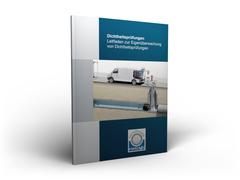
|

Das Fachbuch vermittelt grundlegendes Fachwissen zur Durchführung von Dichtheitsprüfungen an Kanälen, Leitungen und Schächten und dient als Leitfaden zur Eigenüberwachung von Dichtheitsprüfungen. |

|

(Bild: 305090 - Portrait Dr. Friede) Kanalisationen müssen nach den gültigen Regelwerken dauerhaft, funktionssicher und dicht sein. Der vorliegende Leitfaden wurde mit dem Ziel erstellt, dem für den Neubau von Kanälen verantwortlichen Personenkreis bei Kommunen und Entwässerungsbetrieben sowie den für sie tätigen Ingenieurbüros eine praxisorientierte Arbeitshilfe für die Durchführung von Dichtheitprüfungen zur Verfügung zu stellen, da die Dichtheitprüfung … |

|

|

|

| Wichtig: | Kanalisationen müssen nach ATV-A 139 [ATVA139:1988] sowie DIN EN 752 [DINEN752c] dauerhaft, funktionssicher und dicht sein. Dies bedeutet, daß weder Stoffe in das Grundwasser gelangen dürfen noch das Grundwasser abgeleitet werden darf, damit eine unzulässige Verunreinigung des Grundwassers und eine unerwünschte Verdünnung des Abwassers vermieden werden. |
Die Überprüfung der Dichtheit eines fertiggestellten Kanals ist daher als Teil der … |
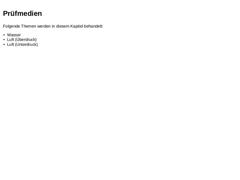
|

| Wichtig: |
Als Prüfmedien für die Durchführung von Dichtheitsprüfungen stehen Wasser (Abschnitt 1.2.1) sowie Luft zur Verfügung, wobei bei der Prüfung mit Luft zusätzlich zu unterscheiden ist zwischen einer Über- (Abschnitt 1.2.2) und einer Unterdruckprüfung (Abschnitt 1.2.3). |
|

|

(Bild: Wasserbefüllung)
Wasser ist im Rahmen der für Dichtheitsprüfungen anzunehmenden Randbedingungen physikalisch als weitgehend inkompressibel einzustufen, d.h. das Volumen des Wassers nimmt bei steigendem Druck nicht nennenswert ab.
Der Prüfdruck wird durch eine Wassersäule erzeugt und variiert entsprechend der statischen Druckhöhe des Wassers sowohl über den Rohrquerschnitt (Druck am Rohrscheitel geringer als an der Rohrsohle) als auch - abhängig … |

|

(Bild: Prinzip für die Luftüber- und Unterdruckprüfung von Kanal und Anschluss (ohne Darstellung der Ausschubsicherung) nach DWA-A 139)
Im Gegensatz zu Wasser ist Luft kompressibel, d.h. das Volumen der in den Prüfraum eingebrachten Luft nimmt bei steigendem Druck ab, es kann somit Energie "gespeichert" werden.
Aufgrund der kompressiblen Eigenschaften von Luft hat das Volumen des Prüfraumes einen erheblichen Einfluss auf das Prüfergebnis, so dass … |
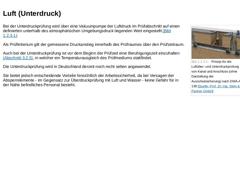
|

(Bild: Prinzip für die Luftüber- und Unterdruckprüfung von Kanal und Anschluss (ohne Darstellung der Ausschubsicherung) nach DWA-A 139)
Bei der Unterdruckprüfung wird über eine Vakuumpumpe der Luftdruck im Prüfabschnitt auf einen definierten unterhalb des atmosphärischen Umgebungsdruck liegenden Wert eingestellt (Bild 1.2.3).
Als Prüfkriterium gilt der gemessene Druckanstieg innerhalb des Prüfraumes über den Prüfzeitraum.
Auch bei der Unterdruckprüfung … |

|

| (Bild: Haltung) | | (Bild: Haltungsabschnitte) | | (Bild: Einzelrohre) | | (Bild: Rohrverbindungen) | | (Bild: Schächte) |
Je nach Anforderung und örtlichen Randbedingungen ist es möglich, - ganze Haltungen (d.h. von Schacht zu Schacht) (Abschnitt 1.3.1),
- Abschnitte einer Haltung (z.B. zwischen zwei Anschlüssen) (Abschnitt 1.3.2),
- einzelne Rohre,
- einzelne Rohrverbindungen (Muffen) (Abschnitt 1.3.3) sowie
- Schächte bzw. Inspektionsöffnungen (Abschnitt 1.3.3)
auf Dichtheit … |

|

| (Bild: Haltung) | Die haltungsweise Dichtheitsprüfung (Bild 1.3.1) stellt bei Neubaumaßnahmen von Abwasserleitungen und -kanälen insbesondere im Bereich kleinerer Nennweiten das am häufigsten angewandte Prüfverfahren dar. |
Hierbei wird die Haltung jeweils an den Schächten mit einem Absperrelement verschlossen und mit dem gewählten Prüfmedium gefüllt.
Hierfür sind auch sämtliche vorhandene Abzweige und Einmündungen mit geeigneten Dichtelementen zu verschließen. |
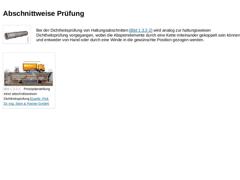
|

| (Bild: Haltungsabschnitte) | Bei der Dichtheitsprüfung von Haltungsabschnitten (Bild 1.3.2) wird analog zur haltungsweisen Dichtheitsprüfung vorgegangen, wobei die Absperrelemente durch eine Kette miteinander gekoppelt sein können und entweder von Hand oder durch eine Winde in die gewünschte Position gezogen werden. |
(Bild: Prinzipdarstellung einer abschnittsweisen Dichtheitsprüfung) |
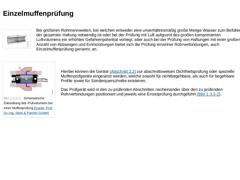
|

| (Bild: Rohrverbindungen) | Bei größeren Rohrnennweiten, bei welchen entweder eine unverhältnismäßig große Menge Wasser zum Befüllen der gesamten Haltung notwendig ist oder bei der Prüfung mit Luft aufgrund des großen komprimierten Luftvolumens ein erhöhtes Gefahrenpotential vorliegt, aber auch bei der Prüfung von Haltungen mit einer großen Anzahl von Abzweigen und Einmündungen bietet sich die Prüfung einzelner Rohrverbindungen, auch Einzelmuffenprüfung … |
|
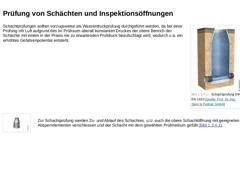
|

(Bild: Schachtprüfung DIN EN 1610)
Schachtprüfungen sollten vorzugsweise als Wasserdruckprüfung durchgeführt werden, da bei einer Prüfung mit Luft aufgrund des im Prüfraum überall konstanten Druckes der obere Bereich der Schächte mit einem in der Praxis nie zu erwartenden Prüfdruck beaufschlagt wird, wodurch u.a. ein erhöhtes Gefahrenpotential entsteht. | (Bild: Schächte) |
Zur Schachtprüfung werden Zu- und Ablauf des Schachtes, u.U. auch die obere … |
|
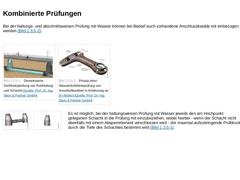
|

Bei der haltungs- und abschnittsweisen Prüfung mit Wasser können bei Bedarf auch vorhandene Anschlusskanäle mit einbezogen werden (Bild 1.3.5).
| (Bild: Gemeinsame Dichtheitsprüfung von Rohrleitung und Schacht) | (Bild: Prinzip einer Wasserdichtheitsprüfung von Anschlußkanälen in Anlehnung an [FI-Müller] [Bild: S&P GmbH]) |
| (Bild: Haltung) | (Bild: Schächte) |
| Es ist möglich, bei der haltungsweisen Prüfung mit Wasser jeweils den am Hochpunkt gelegenen Schacht … |
|

|

|

|

Am Markt existiert eine Vielzahl von Absperrelementen (Abschnitt 2.2) und Muffenprüfgeräten (Abschnitt 2.3), welche die Durchführung von Dichtheitsprüfungen an nahezu jedem beliebigen Rohrprofil ermöglichen.
Die Geräte müssen robust sein und dem Anwendungsbereich entsprechend eingesetzt werden. Sie sind vom Hersteller durch ein Typenschild dauerhaft zu kennzeichnen, auf dem deutlich lesbar folgende Angaben angebracht werden müssen: |

|

Bei den Absperrelementen, auch Rohrverschlüsse oder Rohrabsperrgeräte genannt, ist im Wesentlichen zu unterscheiden zwischen Absperrblasen (Abschnitt 2.2.1) und Absperrscheiben (Abschnitt 2.2.2).
Die meisten handelsüblichen Absperrelemente sind primär für Überdruckprüfungen konzipiert und können nicht ohne weiteres für Unterdruckprüfungen eingesetzt werden.
|
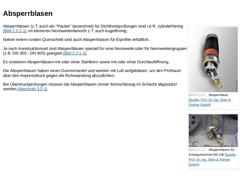
|

|
(Bild: Absperrblase)
|
|
(Bild: Absperrblasen für Kreisquerschnitt DN 100)
|
Absperrblasen (z.T. auch als "Packer" bezeichnet) für Dichtheitsprüfungen sind i.d.R. zylinderförmig (Bild 2.2.1), im kleineren Nennweitenbereich z.T. auch kugelförmig.
Neben einem runden Querschnitt sind auch Absperrblasen für Eiprofile erhältlich.
Je nach Konstruktionsart sind Absperrblasen speziell für eine Nennweite oder für Nennweitengruppen (z.B. DN 300 - DN 600) geeignet
|
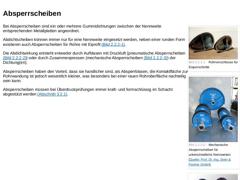
|

|
(Bild: Rohrverschlüsse für Eiquerschnitte)
|
|
(Bild: Mechanische Absperrscheiben für unterschiedliche Nennweiten)
|
|
(Bild: Pneumatische Absperrscheiben für verschiedene Nennweiten)
|
Bei Absperrscheiben sind ein oder mehrere Gummidichtungen zwischen der Nennweite entsprechenden Metallplatten angeordnet.
Abdichtscheiben können immer nur für eine Nennweite eingesetzt werden, neben einer runden Form existieren auch Absperrscheiben für Rohre mit Eiprofil
|
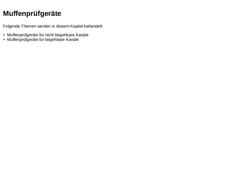
|

Für Muffenprüfungen können analog zur abschnittsweisen Dichtheitsprüfung prinzipiell zwei herkömmliche, mit einer Kette oder Schubstange verbundene Absperrblasen eingesetzt werden, welche über der zu prüfenden Rohrverbindung positioniert werden.
Darüber hinaus existiert auf dem Markt eine Vielzahl von speziellen Muffenprüfgeräten.
|
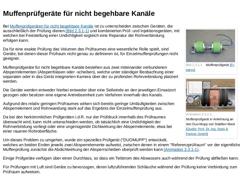
|

| (Bild: Muffenprüfgerät [FI-epros]) | | |
Bei (Beispiele für Muffenprüfgeräte (nicht begehbare Kanäle)) ist zu unterscheiden zwischen Geräten, die ausschließlich der Prüfung dienen (Bild 2.3.1) und kombinierten Prüf- und Injektionsgeräten, mit welchen bei Feststellung einer Undichtigkeit sogleich eine Reparatur der Rohrverbindung erfolgen kann.
Da für eine exakte Prüfung das Volumen des Prüfraumes eine wesentliche Rolle spielt, sind Geräte, bei denen … |
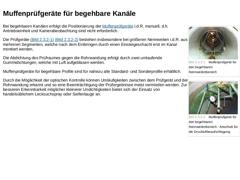
|

| (Bild: Muffenprüfgerät für den begehbaren Nennweitenbereich) | | (Bild: Muffenprüfgerät für den begehbaren Nennweitenbereich - Anschluß für die Druckluftbeaufschlagung) |
Bei begehbaren Kanälen erfolgt die Positionierung der (Beispiele für Muffenprüfgeräte (begehbare Kanäle)) i.d.R. manuell, d.h. Antriebseinheit und Kamerabeobachtung sind nicht erforderlich.
Die Prüfgeräte (Bild 2.3.2) (Bild 2.3.2) bestehen insbesondere bei größeren Nennweiten i.d.R. … |

|

|
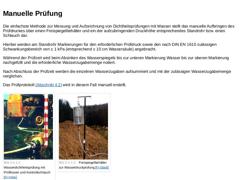
|

Die einfachste Methode zur Messung und Aufzeichnung von Dichtheitsprüfungen mit Wasser stellt das manuelle Aufbringen des Prüfdruckes über einen Freispiegelbehälter und ein der aufzubringenden Druckhöhe entsprechendes Standrohr bzw. einen Schlauch dar.
Hierbei werden am Standrohr Markierungen für den erforderlichen Prüfdruck sowie den nach DIN EN 1610 zulässigen Schwankungsbereich von ± 1 kPa (entsprechend ± 10 cm Wassersäule) angebracht.
Während …
|